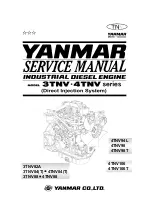
Maintenance Section
-124-
Causes of Fork Failure
Improper Modification or Repair
Fork failure can occur as a result of a field modification
involving welding, flame cutting or other similar
processes which affect the heat treatment and reduces
the strength of the fork.
In most cases, specific processes and techniques are
also required to achieve proper welding of the particular
alloy steels involved. Critical areas most likely to be
affected by improper processing are the heel section,
the mounting components and the fork tip.
Bent or Twisted Forks
Forks can be bent out of shape by extreme overloading,
glancing blows against walls or other solid objects or
using the fork tip as a pry bar.
Bent or twisted forks are much more likely to break and
cause damage or injury. They should be removed from
service immediately.
Fatigue
Parts which are subjected to repeated or fluctuating
loads can fail after a large number of loading cycles
even though the maximum stress was below the static
strength of the part.
The first sign of a fatigue failure is usually a crack which
starts in an area of high stress concentration This is
usually in the heel section or on the fork mounting.
As the crack progresses under repetitive load cycling,
the load bearing cross section of the remaining metal is
decreased in size until it becomes insufficient to support
the load and complete failure occurs.
Fatigue failure is the most common mode of fork failure.
It is also one which can be anticipated and prevented by
recognizing the conditions which lead up to the failure
and by removing the fork service prior to failing.
z
Repetitive Overloading
Repetitive cycling of loads which exceeds the fatigue
strength of the material can lead to fatigue failure. The
overload could be caused by loads in excess of the
rated fork capacity and by use of the forks tips as pry
bars. Also, by handling loads in a manner which causes
the fork tips to spread and the forks to twist laterally
about their mountings.
z
Wear
Forks are constantly subjected to abrasion as they slide
on floors and loads. The thickness of the fork blade is
gradually reduced to the point where it may not be
capable of handling the load for which it was designed.
z
Stress Risers
Scratches, nicks and corrosion are points of high stress
concentration where cracks can develop. These cracks
can progress under repetitive loading in a typical mode
of fatigue failure.
Overloading
Extreme overloading can cause permanent bending or
immediate failure of the forks. Using forks of less
capacity than the load or lift truck when lifting loads and
using forks in a manner for which they were not
designed are some common causes of overloading.
https://www.forkliftpdfmanuals.com/
Содержание D35S-5
Страница 2: ...https www forkliftpdfmanuals com ...
Страница 31: ...Safety Section 29 Lean away from the direction of fall Lean forward https www forkliftpdfmanuals com ...
Страница 41: ...General Section 39 Capacity Chart D G 35S 5 D G 40S 5 D G 45S 5 https www forkliftpdfmanuals com ...
Страница 42: ...General Section 40 Capacity Chart D G 35S 5 D G 40S 5 D G 45S 5 https www forkliftpdfmanuals com ...
Страница 45: ...General Section 43 Capacity Chart D G 40SC 5 D G 45SC 5 D G 50SC 5 https www forkliftpdfmanuals com ...
Страница 46: ...General Section 44 Capacity Chart D G 40SC 5 D G 45SC 5 D G 50SC 5 https www forkliftpdfmanuals com ...
Страница 49: ...General Section 47 Capacity Chart D G 50C 2 D G 50C 5 https www forkliftpdfmanuals com ...
Страница 50: ...General Section 48 Capacity Chart with Side Shifter D G 50C 2 D G 50C 5 https www forkliftpdfmanuals com ...
Страница 196: ...https www forkliftpdfmanuals com ...
Страница 225: ...Safety Section 29 Lean away from the direction of fall Lean forward https www forkliftpdfmanuals com ...
















































